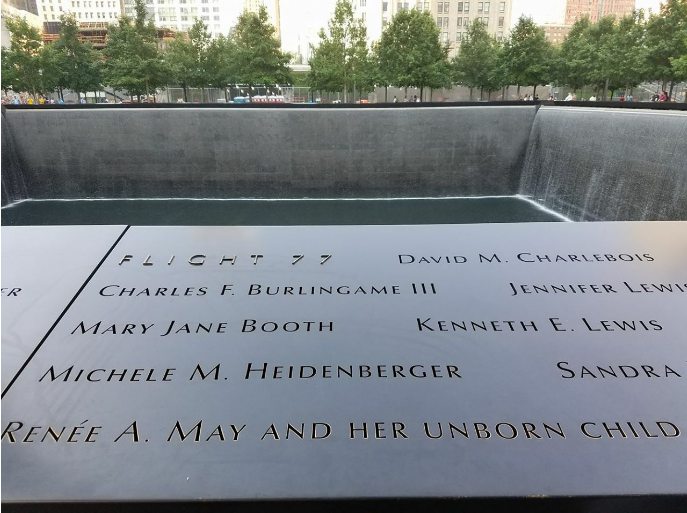By: Tori Lubin
Two massive rectangular fountains lie parallel to each other at 180 Greenwich St. in New York City. Water from all sides spills into the the center of the massive basin, which almost looks like an everlasting stream of tears. The names of all fatalities during the 9/11 attack are emblazoned in bronze panels along each side of both fountains.
These fountains are located directly where the World Trade Center stood 15 years ago.
“I thought the memorial was beautiful, especially the waterfalls,” said Alison Partner ’18, who visited the memorial last year.
Today, the location of the previous World Trade Center functions as a memorial to commemorate those who lost their lives during the terrorist attack on September 11th, 2001. It includes a wide variety of exhibits, including an interactive look into the particulars of the attack that day, as well as first hand accounts of survivors present at the time of the bombing.
The Museum sections into four main exhibits: the Historical Exhibition, the Memorial Exhibition, Witness at Ground Zero and Rebirth at Ground Zero. Each exhibit has a special function in honoring 9/11 victims.
The Historical Exhibition relays the narrative of 9/11 with artifacts, pictures, and eyewitness reports. There are three parts to the Historical Exhibition section, which explain the events of 9/11 in chronological order. It starts with Before 9/11, then proceeds to the Events of the Day 9/11, and ends with After 9/11.
The Memorial Exhibition focuses less on the details of the events that occurred on 9/11, but serves as a tribute to each individual who lost their life during the attack. Interactive screen tables allow visitors to learn more about each victim through personalized recordings by the deceased’s loved ones.
The museum contains audio accounts of phone calls made by passengers on the airplanes that carried out terrorist attacks.
“It was devastating to hear the voices of passengers when the plane was being hijacked,” Anna Greenspan ’18 said. “I could hear the fear and helplessness in their voices as they rushed to tell their loved ones how they felt. It was incredibly powerful.”
The Witness at Ground Zero exhibit takes a more visual approach to documenting the events of 9/11. Photographer Stephane Sednaoui filmed and witnessed the rescue endeavors at the scene of the tragedy. His photographs help museum visitors to picture the horrors of that day.
Rebirth at Ground Zero is also a prominent exhibit featured at the 9/11 Memorial. This exhibit includes a panoramic view of the location of the former World Trade Center through a time lapse that displays the physical transformation of the area. It also includes audio accounts of people who were significantly affected by the events of 9/11.
Visitors of the memorial not only feel the loss of the men and women that were lost that day, but also recognize the importance of this historical event in America’s history.
“The people who lost their lives on 9/11 were just ordinary people, living their ordinary lives,” Greenspan said. “It emphasizes how important it is to enjoy life and not take it for granted because, unfortunately, you just never know what might happen.”














































